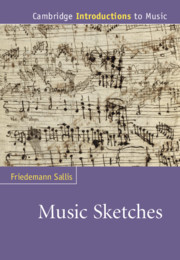Book contents
- Frontmatter
- dedication
- Contents
- List of figures
- List of music examples
- List of tables
- Preface
- Chapter 1 Introduction
- Chapter 2 Sketch studies past and present
- Chapter 3 Tracking down evidence of the creative process
- Chapter 4 The physical objects of the compositional process
- Chapter 5 Studying loose leaves
- Chapter 6 Sketchbooks
- Chapter 7 Transcription and facsimile reproduction
- Chapter 8 Sketches and the critical edition of music
- Chapter 9 Dangerous liaisons: the evolving relationship between sketch studies and analysis
- Chapter 10 Musical palimpsests and authorship
- Appendix: Beethoven sketchbooks published between 1913 and 2013
- Notes
- Glossary
- Bibliography
- Index
Chapter 10 - Musical palimpsests and authorship
Published online by Cambridge University Press: 05 February 2015
- Frontmatter
- dedication
- Contents
- List of figures
- List of music examples
- List of tables
- Preface
- Chapter 1 Introduction
- Chapter 2 Sketch studies past and present
- Chapter 3 Tracking down evidence of the creative process
- Chapter 4 The physical objects of the compositional process
- Chapter 5 Studying loose leaves
- Chapter 6 Sketchbooks
- Chapter 7 Transcription and facsimile reproduction
- Chapter 8 Sketches and the critical edition of music
- Chapter 9 Dangerous liaisons: the evolving relationship between sketch studies and analysis
- Chapter 10 Musical palimpsests and authorship
- Appendix: Beethoven sketchbooks published between 1913 and 2013
- Notes
- Glossary
- Bibliography
- Index
Summary
Terms and concepts, arguments and polemics
A palimpsest is a flat surface from which a handwritten document was at least partially removed or erased, and on which a new text was written. The term comes from Greek and means to scrape or rub again. Traditionally it refers to parchments that were reused during the late Middle Ages. In the early modern period, the cartella or erasable tablet on which musicians composed sections and worked out problems was sometimes called a palimpsestus compositorius (see Chapter 5). In this chapter, we will examine questions that arise when composers’ working documents are (re)used to create something new. This topic was briefly addressed in the discussion of Vadim Bibergan’s reconstruction of the lost score of Shostakovich’s music for an animated film, The Story of the Priest and His Helper Balda, Op. 36 (see Chapter 8). Here we will examine the completion of works left unfinished following the composer’s death and the writing of entirely new works based on surviving sketch material. Robert Levin’s completion of the first movement of Mozart’s Concerto in D for violin and piano, KV Anh. 56/315f constitutes an example of the former category. An example of the latter would be Charles Wuorinen’s Reliquary for Igor Stravinsky for orchestra (1974–5), based on what are believed to be Stravinsky’s final sketches.
The work of Levin and Wuorinen should not be confused with:
editorial reconstructions of lost manuscripts (see Chapter 8), because in the cases we will discuss in this chapter, the finished work was never completed;
forgeries, because the role of the original and subsequent composer/musicologist is publicly acknowledged;
elaborations of an earlier composer’s style in the sense of Variations on a theme by Haydn, Op. 56 by Johannes Brahms, because the surviving sketches identify the original composer’s intention to complete the projected work.
- Type
- Chapter
- Information
- Music Sketches , pp. 177 - 193Publisher: Cambridge University PressPrint publication year: 2015

